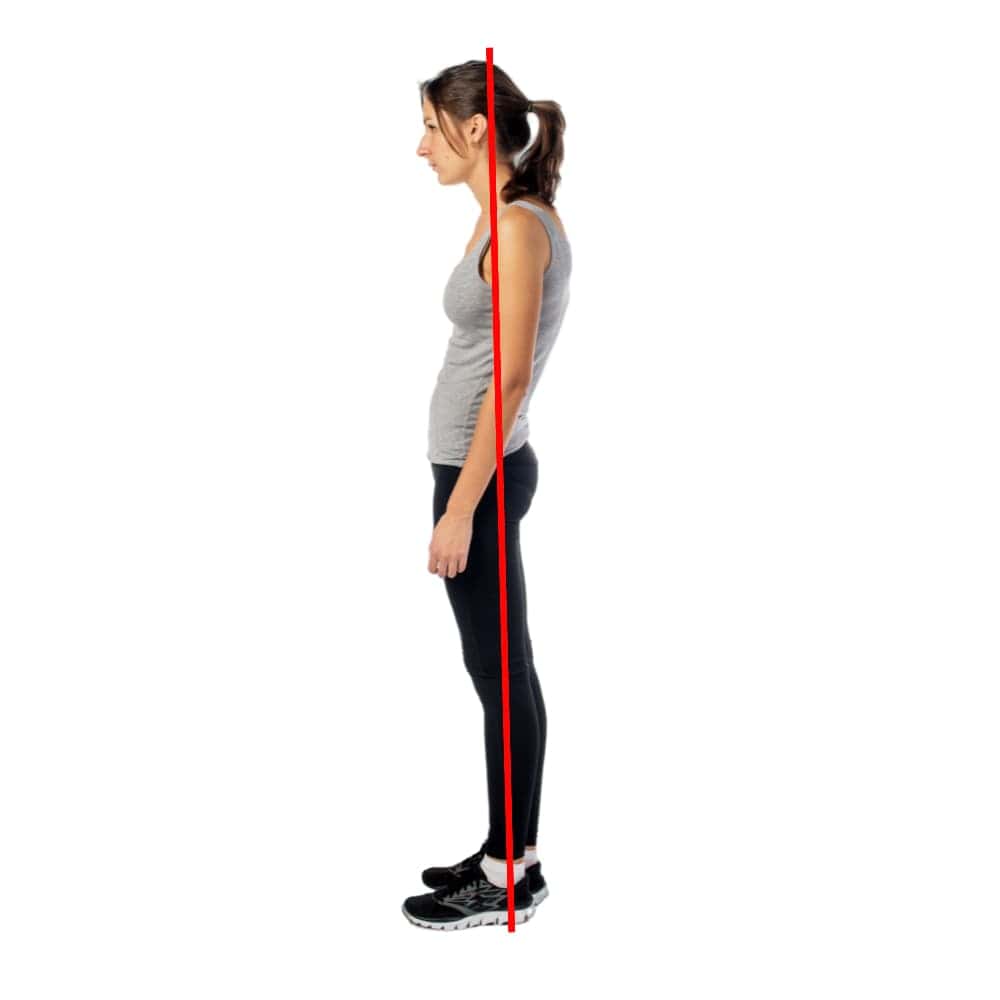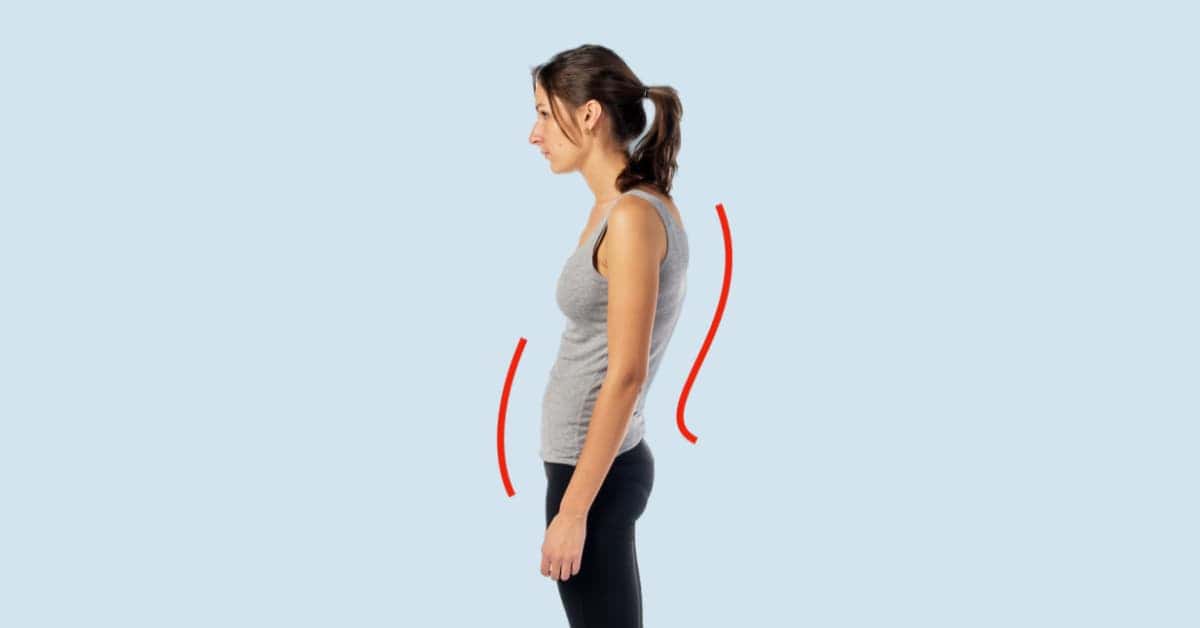Swayback posture is a widespread posture issue that people unknowingly struggle with. This posture is characterized by an exaggerated curve in the lower back and a tendency to lean back when standing or walking.
This issue extends beyond mere aesthetics, as uncorrected swayback posture can lead to discomfort, such as lower back pain, stiffness, and movement difficulties. Recognizing and addressing this issue is vital and can be managed effectively from home.
I. Understanding Swayback Posture

Swayback posture is a common postural problem, particularly among those who lead sedentary lifestyles or work desk jobs. It’s characterized by a noticeable forward shift of the hips, and an overextension of the lower back, which gives the appearance of ‘swaying back.’
A simple way to visualize swayback posture is by drawing an imaginary vertical line starting from the ankle. In individuals with a healthy posture, this line should pass through the hips and extend up to the head, indicating that the body’s weight is distributed evenly. However, in swayback posture, the hips are positioned forward of this line, disrupting the body’s natural alignment.
This displacement of the hips can lead to an exaggerated inward curve of the lower spine, known as lordosis. The abdomen might protrude, and the buttocks may appear flatter due to the altered pelvis position. Additionally, the upper back may round as a compensatory response, a condition known as kyphosis.
Swayback posture can lead to various physical discomforts. These can include lower back pain, neck and shoulder tension, reduced balance and stability, decreased mobility, and an increased risk of injury if left unaddressed. Therefore, correcting swayback posture is crucial for maintaining good overall physical health.
II. Causes of Swayback Posture
Understanding the causes of swayback posture is a crucial step towards rectification. Here are some common causes:
- Sleeping on the stomach on a soft mattress: This sleeping position pushes your hips forward, contributing to the development of swayback posture.
- Incorrect sitting and standing positions: Spending long hours in incorrect postures, like slouching in front of a computer or standing with protruding hips, can gradually lead to swayback posture.
- Excessive stretching of the hip flexors: Overstretching these muscles can make them long and weak, altering the pelvic alignment and contributing to swayback posture.
These poor posture habits can lead to muscle imbalances, including short and tight hamstrings, tight abdominals, weak hip flexors, weak external obliques, and glute muscles that are either weak or not activated. All these imbalances contribute to swayback posture.
Furthermore, these imbalances and poor habits can cause other postural problems like posterior pelvic tilt, forward head posture, and hunchback posture. These issues equally need addressing to make progress in correcting swayback posture.
Addressing these causes is essential not only for correcting swayback posture but also for avoiding potential additional postural complications. By being aware of these contributing factors, you can make more informed decisions about your daily habits and exercise routines.
III. The Plan to Fix Swayback Posture
Correcting swayback posture involves a multi-faceted approach that targets various muscles in your body. Here’s a snapshot of the plan we will be following:
- Massaging: Massage therapy is an effective way to relieve muscle tension. By focusing on specific muscle groups like the hamstrings and the abdomen, massage can help release trigger points and knots contributing to your swayback posture.
- Stretching: Regular stretching is crucial for increasing muscle flexibility and length. The hamstrings and abdominals, which are typically tight in individuals with swayback posture, will be the primary focus of our stretching exercises.
- Strengthening: This plan component aims to build strength in the muscles that have grown weak due to postural imbalances. We’ll target the core, obliques, hip flexors, and glutes with specific exercises designed to restore muscle balance and aid in posture correction.
This comprehensive approach will tackle swayback posture from all angles – relieving muscle tension, increasing flexibility, and building strength. By following the upcoming detailed instructions, you’ll be well on your way to improving your posture and reducing any associated discomfort.
IV. Massaging Techniques
Before beginning the exercises, preparing your muscles through massage is beneficial. This practice can help alleviate any present muscle tension and increase flexibility.
Foam rolling the hamstrings
- Begin by sitting on the floor with the foam roller placed under your thighs.
- Support your weight with your hands placed on the floor behind you.
- Roll back and forth from your knees to your buttocks.
- Focus more on any areas that feel particularly tight or sore.
Massage ball for hamstrings
If you didn’t find using a foam roller on your hamstrings intense enough, you could use a massage ball instead.
- Sit on a sturdy surface like a bench or a hard chair.
- Place a massage ball under one thigh, right on your hamstring muscles.
- Apply pressure and start rolling the ball by moving your leg back and forth.
- Spend more time on areas that feel particularly tight or painful.
Massage ball for abdominals
To perform this abdominal massage, you will need a large massage ball. The 5 Inch MB5 ball would work well for this massage.
- Lie down flat on your back with a massage ball under your abdomen.
- Move your body gently to roll the ball around your abdomen.
- Apply pressure to any areas that feel tight or tender, but avoid direct pressure on the spine.
V. Stretching Exercises
After massaging, we’ll move on to stretching. Stretching helps to increase flexibility, improves circulation, and enhances overall muscle function. Here are two essential stretches for addressing swayback posture.
Hamstring stretch
- Stand upright and place one foot on an elevated surface, such as a chair or a step.
- Keep your foot flexed and your leg straight.
- Bend forward from the hips, keeping your back straight until you feel a stretch in the back of your thigh.
- Hold this stretch for at least 30 seconds, then switch sides.
Cobra pose abdominal stretch
- Lie face down on the floor with your hands under your shoulders.
- Press your hands into the floor and slowly lift your chest up, extending your spine.
- Keep your hips grounded and your shoulders away from your ears.
- Hold this pose for at least 30 seconds.
VI. Strengthening Exercises
The final piece of the puzzle in addressing swayback posture is strengthening the weak muscles. Here are some exercises that can help to strengthen your core, obliques, hip flexors, and glutes.
Plank
Planks are a great way to strengthen your core and strengthen the muscles to help prevent your hips from swaying forward.
- Get into a push-up position, but rest on your forearms instead of your hands.
- Ensure your body forms a straight line from your head to your heels.
- Engage your core and hold this position for as long as you maintain good form.
Stability ball jackknife
The stability ball jackknife is a great progression from the plank exercise as it requires greater core stability and balance. It also helps with hip flexor activation, which is also lacking in someone with swayback.
- Start in a high plank position with your hands on the floor and your feet on a stability ball.
- Keep your back straight and engage your core as you pull the ball toward your chest by bending your knees.
- Push the ball back to the starting position and repeat.
Side plank
- Start on your side with your feet together and one forearm directly below your shoulder.
- Raise your hips until your body is straight from head to feet.
- Hold this position for as long as you can while maintaining good form.
- Repeat on the other side.
Suitcase carry
The Suitcase Carry is a functional exercise that is incredibly beneficial in strengthening your core, specifically targeting the oblique muscles.
- Stand tall holding a dumbbell in one hand, like you’re carrying a suitcase.
- Walk forward while keeping your shoulders level and your gaze forward.
- After a certain distance, switch the dumbbell to the other hand and repeat.
Banded hip flexor activation
This exercise is designed to help activate and strengthen your hip flexors using a small resistance band while lying on your back.
- Lie on your back with a resistance band looped around your feet.
- Keep one leg straight while pulling the knee of the other leg towards your chest.
- Alternate between legs, ensuring you keep tension on the band.
Glute bridge
Glute activation and strengthening exercises can help correct swayback by improving the posture and stability of the pelvis. Any glute exercise can help, but the glute bridge is a great place to start.
- Lie on your back with your knees bent and feet flat on the ground.
- Push through your heels to lift your hips off the ground, squeezing your glutes at the top.
- Lower your hips back down and repeat.
VII. Consistency is Key
To see improvements in your posture, consistency is crucial. Just as poor posture doesn’t develop overnight, correcting it also takes time. Aim to incorporate these exercises into your routine, performing them several times a week. Over time, you should begin to notice improvements in your posture, reduced discomfort, and an increase in overall mobility and strength.
VIII. Professional Guidance
While these exercises are generally safe for most people, it’s always wise to consult with a healthcare provider or a physical therapist before starting any new exercise regimen, especially if you have pre-existing health conditions. They can assess your individual needs and provide guidance tailored specifically for you.
Wrapping Up
Swayback posture may be a common issue, but it’s not something you have to live with. By incorporating these simple massage techniques, stretches, and strengthening exercises into your routine, you can start correcting your posture, relieve discomfort and improve your muscle balance.
Remember, consistency is key and seeking professional guidance is always beneficial. Take one step at a time and you’ll be on your way to better posture and better health.












